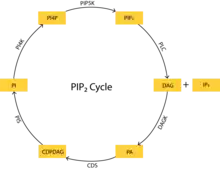PI(4,5)P2 Cycle
The PI(4,5)P2 cycle or simply PIP2 cycle (also known as PI cycle in past) is one of the important signalling cascades underlying many cellular functions including GPCR signaling, cytokinesis,[1] endocytosis,[2] and apoptosis.[3]
Signalling steps

PIP2 cycle involves steps of chemical reactions characterized by various enzymes. First hydrolysis of PIP2 molecules by activated phospholipase C leads to formation of diacylglycerol and inositol trisphosphate. These two are themselves important second messengers.[4] Diacylglycerol further converted into phosphatidic acid (PA) by DAGK enzyme. Furthermore, CDP-diacylglycerol synthetase uses CTP to create cytidine diphosphate diacylglycerol from PA.[5][6] Generated CDP-DAG then condensed to PI by phosphatidylinositol synthase.[7] This PI is then phosphorylated to PI4P and back to PIP2 via action of PI4K and PIP5K[8]
References
- Logan, Michael R.; Mandato, Craig A. (1 June 2006). "Regulation of the actin cytoskeleton by PIP2 in cytokinesis". Biology of the Cell. 98 (6): 377–388. doi:10.1042/BC20050081. PMID 16704377. S2CID 37783775.
- Sun, Yidi; Drubin, David G. (15 December 2012). "The functions of anionic phospholipids during clathrin-mediated endocytosis site initiation and vesicle formation". Journal of Cell Science. 125 (Pt 24): 6157–6165. doi:10.1242/jcs.115741. PMC 3585524. PMID 23097040.
- Mejillano, M.; Yamamoto, M.; Rozelle, A. L.; Sun, H. Q.; Wang, X.; Yin, H. L. (19 January 2001). "Regulation of apoptosis by phosphatidylinositol 4,5-bisphosphate inhibition of caspases, and caspase inactivation of phosphatidylinositol phosphate 5-kinases". The Journal of Biological Chemistry. 276 (3): 1865–1872. doi:10.1074/jbc.M007271200. PMID 11042212.
- Mikoshiba, Katsuhiko (1 September 2007). "IP3 receptor/Ca2+ channel: from discovery to new signaling concepts". Journal of Neurochemistry. 102 (5): 1426–1446. doi:10.1111/j.1471-4159.2007.04825.x. PMID 17697045. S2CID 4242836.
- Christie, William (Bill) W. "Cytidine Diphosphate Diacylglycerol (CDP-DAG), phospholipid biosynthesis - composition and biochemistry". www.lipidhome.co.uk. Retrieved 19 July 2021.
- Liu, Yuan; Wang, Wei; Shui, Guanghou; Huang, Xun (6 March 2014). "CDP-Diacylglycerol Synthetase Coordinates Cell Growth and Fat Storage through Phosphatidylinositol Metabolism and the Insulin Pathway". PLOS Genetics. 10 (3): e1004172. doi:10.1371/journal.pgen.1004172. PMC 3945474. PMID 24603715.
- Bankaitis, Vytas A.; Grabon, Aby (15 November 2011). "Phosphatidylinositol Synthase and Diacylglycerol Platforms Bust a Move". Developmental Cell. 21 (5): 810–812. doi:10.1016/j.devcel.2011.10.016. PMC 3242638. PMID 22075144.
- Bout, Iman van den; Divecha, Nullin (1 November 2009). "PIP5K-driven PtdIns(4,5)P2 synthesis: regulation and cellular functions". J Cell Sci. 122 (21): 3837–3850. doi:10.1242/jcs.056127. PMID 19889969. Retrieved 3 August 2017 – via jcs.biologists.org.